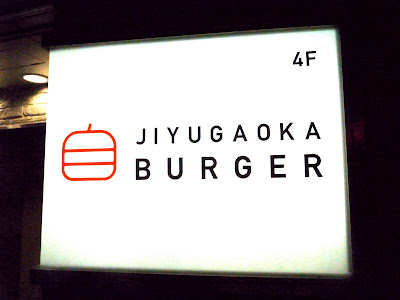First stop is hamburgers. There are a lot of burger joints in Tokyo, including McDonald's, Mos Burger, and Freshness Burger. Also the burger steak has been incorporated into Japanese cuisine and figures as the baaga-suteki (バーガーステキ) served with rice and topped with soy-based sauce and grated radish. But a restaurant in Jiyugaoka (自由が丘) makes the difference by making top-quality Western-style burgers from purely organic ingredients.
The restaurant is quaint. The little space it fits in is typical for a lot of Tokyo establishments. The interiors are cozy and one can find most of the tables on the outdoor terrace.
Guacamole burger set with fried potatoes and coleslaw (Y1640) was ordered. One first gets to taste the buns which are the most perfectly-tasting hamburger buns there could be. It is utterly delicious and fresh, baked bread at its finest, accentuated by the taste of sesame seeds. The guacamole is made from organic avocados, and the beef is likewise organic, and it is Wagyu (和牛). The beef tastes very fresh. Superlatives are to describe this burger as well as the fried potatoes and the coleslaw, which is light and refreshing.
Moving on to flashier Omotesando, the shopping center Omotesando Hills has some culinary treats to offer. On the ground floor is kurkku3 restaurant which offers an alternative view on how meals should be eaten - its menu categorizes food according to the good and qualitative effects it can do on the body (not necessarily medical). Dishes are tagged as energizing, or relaxing, or mood-uplifting, and so on.
The interiors are cool and swanky and one has a view of Omotesando and the passers-by.
First to be ordered is a bowl of Korean Bibimbap (Y1300), with a kurkku3 interpretation. Bits of tender beef are cooked just right and served over rice and topped with poached egg and assorted vegetables (spring onions most markedly). One has to mix together the ingredients and the dish achieves an organic unity, with the poached egg serving as a binder.
Then comes a Vietnamese style spring roll stuffed with green leafy vegetables and fried eel (Y550 for 1 piece, cut in half). It is served with hoisin sauce dusted with ground peanuts. The richness of the eel, which is fatty fish in the first place, is subdued by the vegetables, achieving a delightful balance.
Last stop for this issue is a restaurant in a quieter section of Tokyo. Futako-tamagawa (二子多摩川) seems to be another typical Tokyo neighborhood, appearing more suburban. But with the addition of Rise Shopping Center which has very good shops, there's always a reason to visit this place.
On the top floor of Dogwood Plaza (still included in Rise S.C.) are restaurants. The liveliest of the restaurant seems to be the Pasta House AWKitchen. It's lively enough to even attract groups of elderly Japanese, although the place seems to be a bit too modern and gives the impression of targeting younger groups.
For antipasto, eggplant puttanesca (横浜メスプッタネスカ, Y550) was ordered. The tomatoes are fresh and the taste of anchovies delicately punctuate it. The eggplants are cooked just right with no hint of bitterness.
Last is the pasta - an olive oil based pasta dish of rigatoni in ground chicken and garlic sauce with lotus root (Y1100). The sauce is cooked together with a piece of dried chili which adds some heat. The rigatoni is cooked al dente and is freshly-made (not dried pasta). The serving is a bit on the light side and won't leave someone feeling bloated from too much pasta.
Overall, a good experience it is.
More to come.
* Omotesando (表参道) can be accessed either through the Tokyo Metro on the Hanzomon, Ginza, and Chiyoda lines, and can be reached by foot from 原宿 Harajuku station on the JR Yamanote line.
















